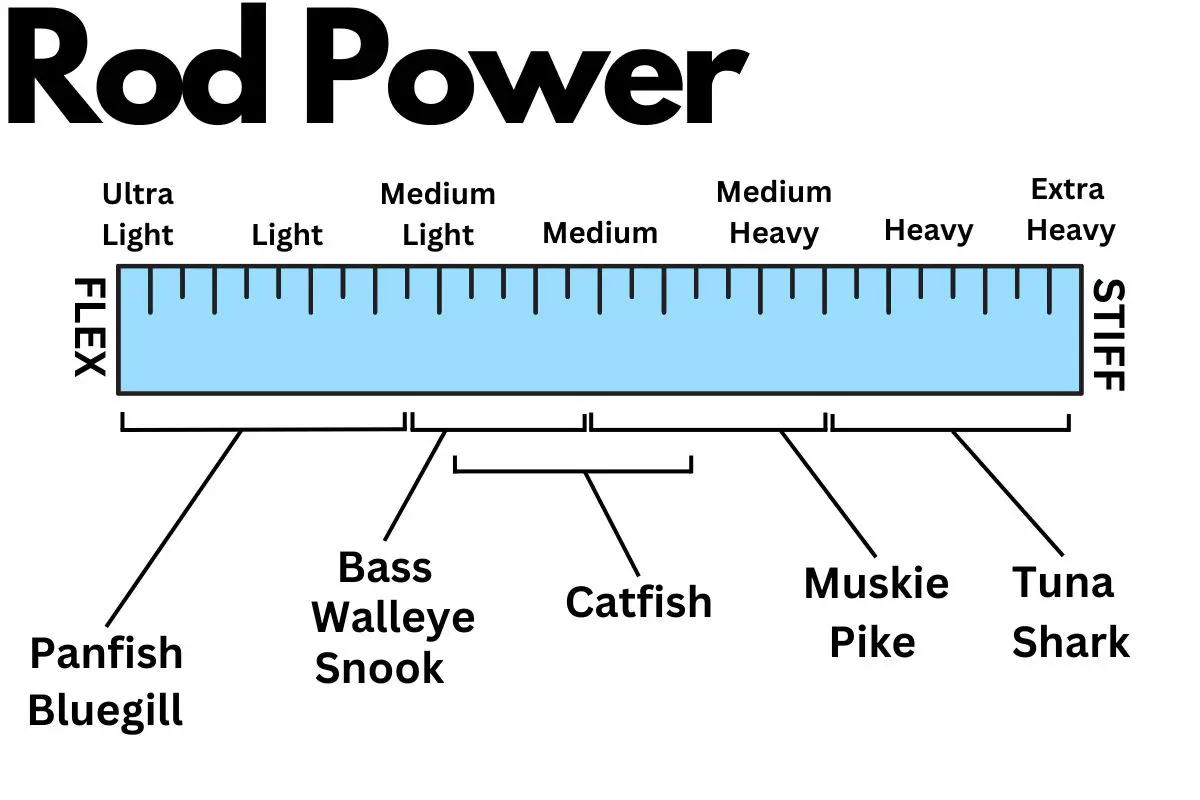Fishing rod power refers to the rod’s resistance to bending or lifting strength. From ultra-light to extra-heavy, it is crucial to determine the appropriate rod for targeting specific fish species and handling various lure weights. Matching rod power to your fishing needs ensures optimal performance.
| Fishing Rod Power | Description | Suitable For |
|---|---|---|
| Ultra-Light | These rods have a very fast, sensitive tip and light overall power. They bend easily even under light pressure. | Targeting small species like panfish, trout, and small perch; using light lures and baits; finesse fishing. |
| Light | Light rods have a fast tip with moderate overall power. They are slightly stiffer than ultra-light rods. | Light lure fishing for species like crappie, small bass, and bluegill; freshwater streams and ponds. |
| Medium-Light | These rods have a moderate-fast tip with slightly more power than light rods. They offer more backbone. | Versatile use in fresh and saltwater for species like bass, walleye, catfish, and snook. |
| Medium | Medium rods have a moderate-fast action and are versatile with a good balance of power and sensitivity. | Versatile use in both freshwater and saltwater for bass, walleye, catfish, and snook. |
| Medium-Heavy | These rods have a fast action and a strong backbone, providing more power for larger lures and fish. | Heavy cover fishing; targeting larger species like pike, muskie, and striped bass; offshore saltwater. |
| Heavy | Heavy rods are very powerful with a fast action, offering a strong backbone and minimal flex. | Big game fishing for species like tuna, sailfish, and marlin; bottom fishing; surf casting. |
| Extra-Heavy | These rods are extremely powerful with a fast action and are designed for the largest fish and toughest conditions. | Deep-sea fishing for large species like shark, grouper, and amberjack; trolling; extreme saltwater fishing. |
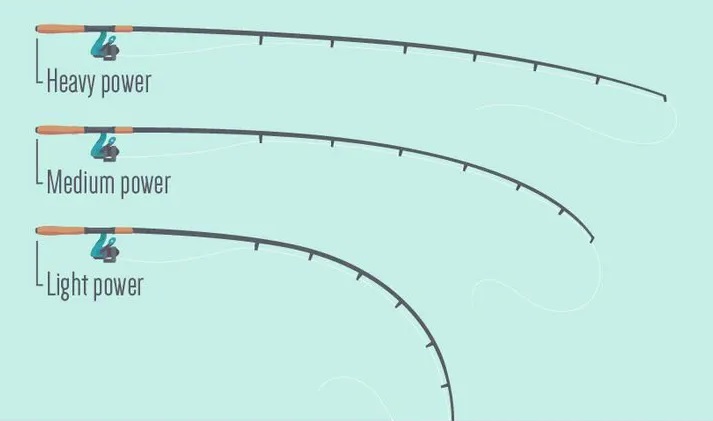
Table of Contents
Ultra-Light
An ultra-light power rod with very light lines, small lures, and targeting smaller fish species should be used. Ultra-light power rods are the most flexible and have a lighter lifting strength than heavier power rods, making them ideal for delicate presentations and subtle bites.
They are used for:
- Fishing with very light lures, such as small jigs, spinners, spoons, and tiny soft plastics, as they provide the right amount of flex for casting and working these lures effectively.
- Targeting smaller fish species with a gentle, subtle bite allows the angler to detect the slightest nibble and enjoy the fight.
- Fishing in clear, calm water or heavily pressured areas requires a delicate presentation and light line to avoid spooking fish.
An ultra-light power rod provides the highest level of sensitivity and flexibility, allowing the angler to cast lightweight lures accurately and feel even the most subtle bites. The rod’s softer action also helps cushion the fight, reducing the chances of the line breaking or the hook pulling out when targeting smaller fish.
I pick ultra-light powered rods when fishing in situations requiring finesse and sensitivity, such as clear water, heavily pressured areas, or targeting smaller fish species. Some species that can be effectively targeted with an ultra-light power rod include panfish (crappie, bluegill, and perch), small trout, and small bass.
Ultra-light power rods are best suited for light lures like small jigs, spinners, spoons, and tiny soft plastics. These types of lures require a delicate presentation and the ability to cast lightweight lures accurately, which an ultra-light power rod can provide.
Additionally, ultra-light rods can be used with live bait, such as worms or small minnows, for a natural and subtle presentation.
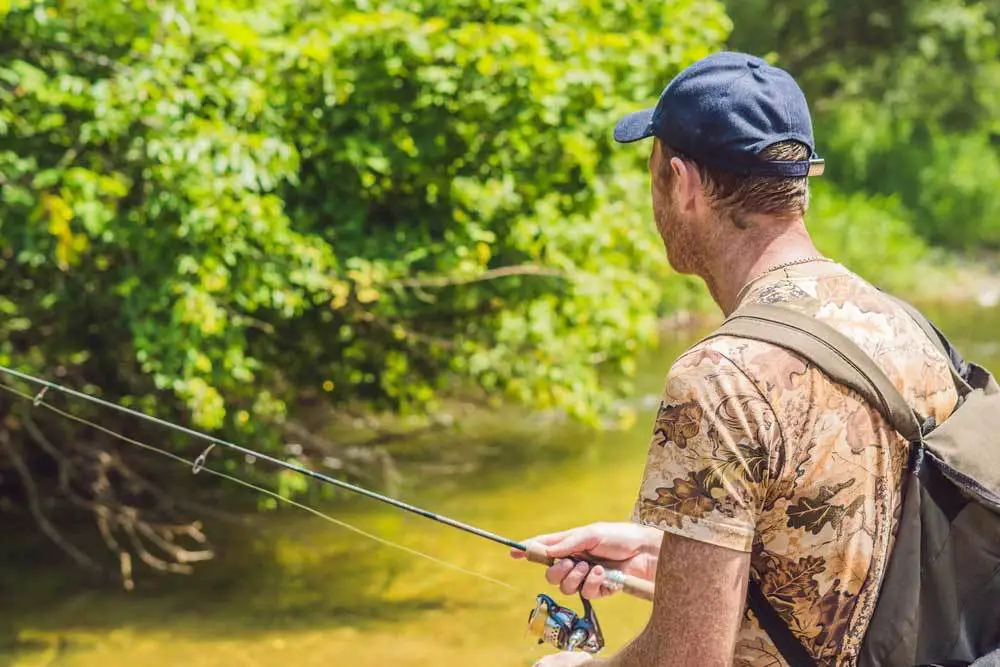
Medium
A medium power rod is designed with a moderate line weight and a wide variety of lures, targeting a range of fish species. Medium power rods are more versatile than ultra-light or heavy power rods, balancing flexibility, lifting strength, and sensitivity.
They are generally used for:
- Fishing with diverse lures, such as crankbaits, spinnerbaits, swimbaits, and soft plastics, offers the right balance of sensitivity and power for effective casting and lure control.
- Targeting a wide variety of fish species, from smaller to moderately-sized fish, which may require different presentations or techniques.
- Fishing in various water conditions, such as murky, clear, or current-heavy environments, where a versatile and adaptable rod is essential.
A medium power rod works by providing a balance between sensitivity, flexibility, and lifting strength. This allows the angler to cast various lures effectively, detect bites, and have enough power to set the hook and fight fish. The rod’s moderate power also helps absorb energy during the fight, reducing the chances of line breakage or hook pulling out.
I use a medium power rod when fishing in situations that require a versatile, all-around performance, or when targeting a variety of species with different habits and preferences. Some species that can be effectively targeted with a medium power rod include bass, walleye, pike, redfish, snook, and striped bass.
Medium power rods are best suited for many lures, including crankbaits, spinnerbaits, swimbaits, and soft plastics. These lures require a balance between sensitivity, power, and casting ability, which a medium power rod can provide. They are also suitable for live bait presentations, offering a versatile option for various fishing situations.
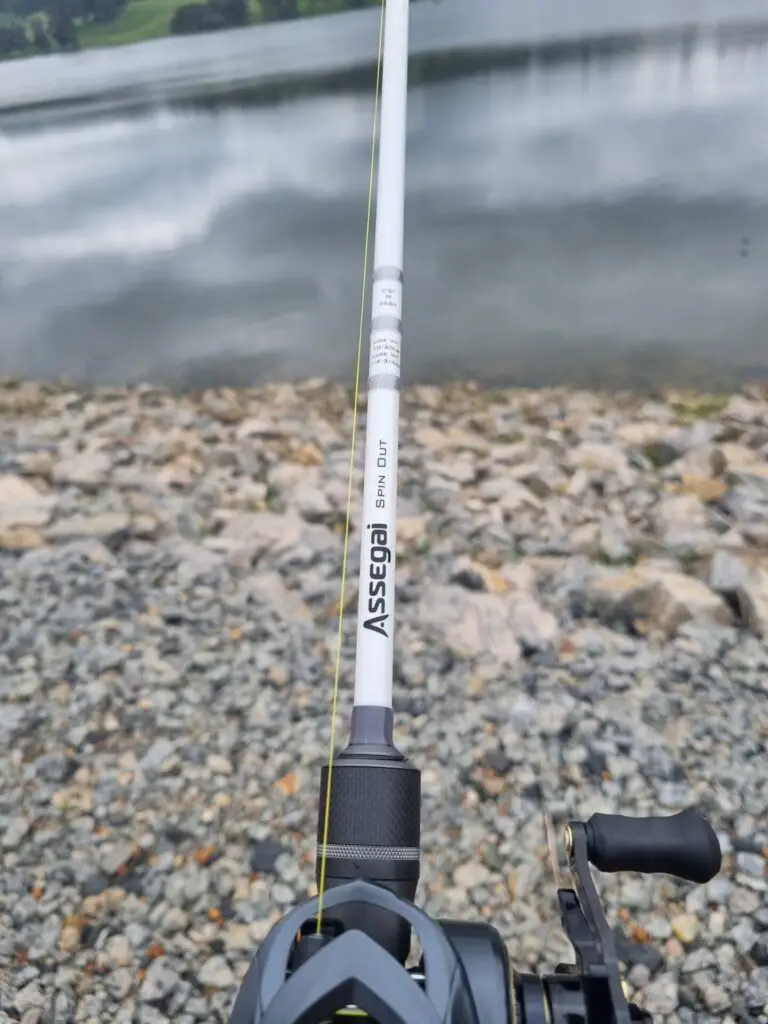
Extra-Heavy
An extra-heavy power rod can handle heavy lines, large lures, and targeting large, powerful fish species. The power of a rod refers to its lifting strength and resistance to bending under load. Extra-heavy power rods are stiffer and much higher lifting strength, making them ideal for battling big, strong fish.
Extra-heavy power rods are used for specific types of fishing techniques and situations requiring high power and strength. They are best suited for:
- Fishing with large, heavy lures, such as big swimbaits, jigs, or trolling lures, as they provide the necessary backbone to cast and control these lures effectively.
- Targeting large, powerful fish species that require strong, sturdy equipment to handle the fight and prevent the fish from escaping.
- Fishing in heavy cover or structure requires a powerful rod to pull fish away from obstacles and prevent break-offs.
An extra-heavy power rod provides a high level of strength and lifting power, allowing the angler to cast and control large lures effectively and battle large, powerful fish. The rod’s stiff backbone also helps to set the hook firmly and maintain control during the fight, preventing the fish from escaping or breaking the line.
I choose extra-heavy power rods when targeting large fish species or fishing in heavy cover or structure. Some species that can be effectively targeted with an extra-heavy power rod include large catfish, muskies, tarpon, tuna, and large sharks.
Extra-heavy power rods are best suited for large, heavy lures like big swimbaits, jigs, or trolling lures. These lures require a powerful rod to cast effectively and maintain control during retrieval. They are also suitable for heavy live bait presentations or fishing with heavy sinkers when targeting large fish species in deep water or strong currents.

Performance
| Rod Power | Power | Flex | Sensitivity |
|---|---|---|---|
| Ultra-Light | ⭐ | ⭐⭐⭐⭐⭐ | ⭐⭐⭐⭐⭐ |
| Light | ⭐⭐ | ⭐⭐⭐⭐ | ⭐⭐⭐⭐ |
| Medium-Light | ⭐⭐⭐ | ⭐⭐⭐ | ⭐⭐⭐⭐ |
| Medium | ⭐⭐⭐ | ⭐⭐⭐ | ⭐⭐⭐ |
| Medium-Heavy | ⭐⭐⭐⭐ | ⭐⭐ | ⭐⭐ |
| Heavy | ⭐⭐⭐⭐⭐ | ⭐ | ⭐⭐ |
| Extra-Heavy | ⭐⭐⭐⭐⭐ | ⭐ | ⭐ |
Fishing Rod Power vs Action
Power and action are two key characteristics of fishing rods that contribute to their overall performance and suitability for specific angling situations.
Power refers to the rod’s backbone, or its resistance to bending under load. From ultra-light to extra-heavy, power determines the types of lures and line weights a rod can handle and the size of the fish it can effectively target. Lighter power rods are ideal for targeting smaller species with finesse techniques. Heavier power rods are designed to handle large lures and reel in bigger fish without compromising the rod’s structural integrity.
Action denotes the point along the rod where it bends when a load is applied. It can be classified as slow, moderate, or fast, with variations. Slow-action rods bend more uniformly from the tip to the butt, providing greater flexibility and cushioning for lighter lines and smaller fish. Fast-action rods bend primarily at the tip, offering a quick, decisive response to strikes and greater sensitivity for detecting subtle bites. Moderate-action rods strike a balance between the two, providing versatility in various fishing scenarios.
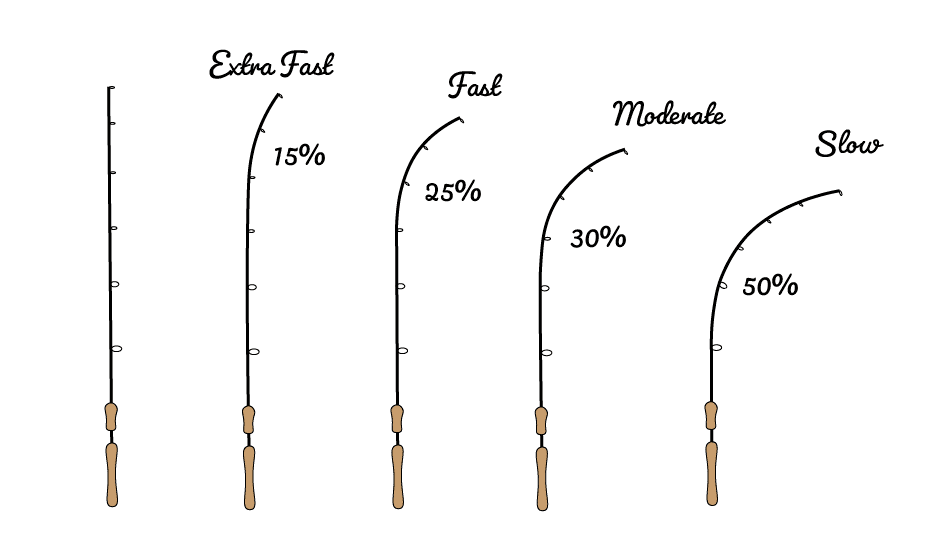
Rod Power by Species
| Fish Species | Recommended Fishing Rod Power |
|---|---|
| Largemouth Bass | Medium to Heavy |
| Smallmouth Bass | Light to Medium |
| Rainbow Trout | Light to Medium-Light |
| Brown Trout | Light to Medium-Light |
| Brook Trout | Ultralight to Light |
| Walleye | Medium to Medium-Heavy |
| Northern Pike | Medium-Heavy to Heavy |
| Muskellunge (Muskie) | Heavy to Extra-Heavy |
| Common Carp | Medium to Heavy |
| Channel Catfish | Medium-Heavy to Heavy |
| Flathead Catfish | Heavy to Extra-Heavy |
| Blue Catfish | Heavy to Extra-Heavy |
| Crappie | Ultralight to Light |
| Bluegill | Ultralight to Light |
| Redfish (Red Drum) | Medium to Medium-Heavy |
| Spotted Seatrout | Light to Medium-Light |
| Striped Bass | Medium to Heavy |
